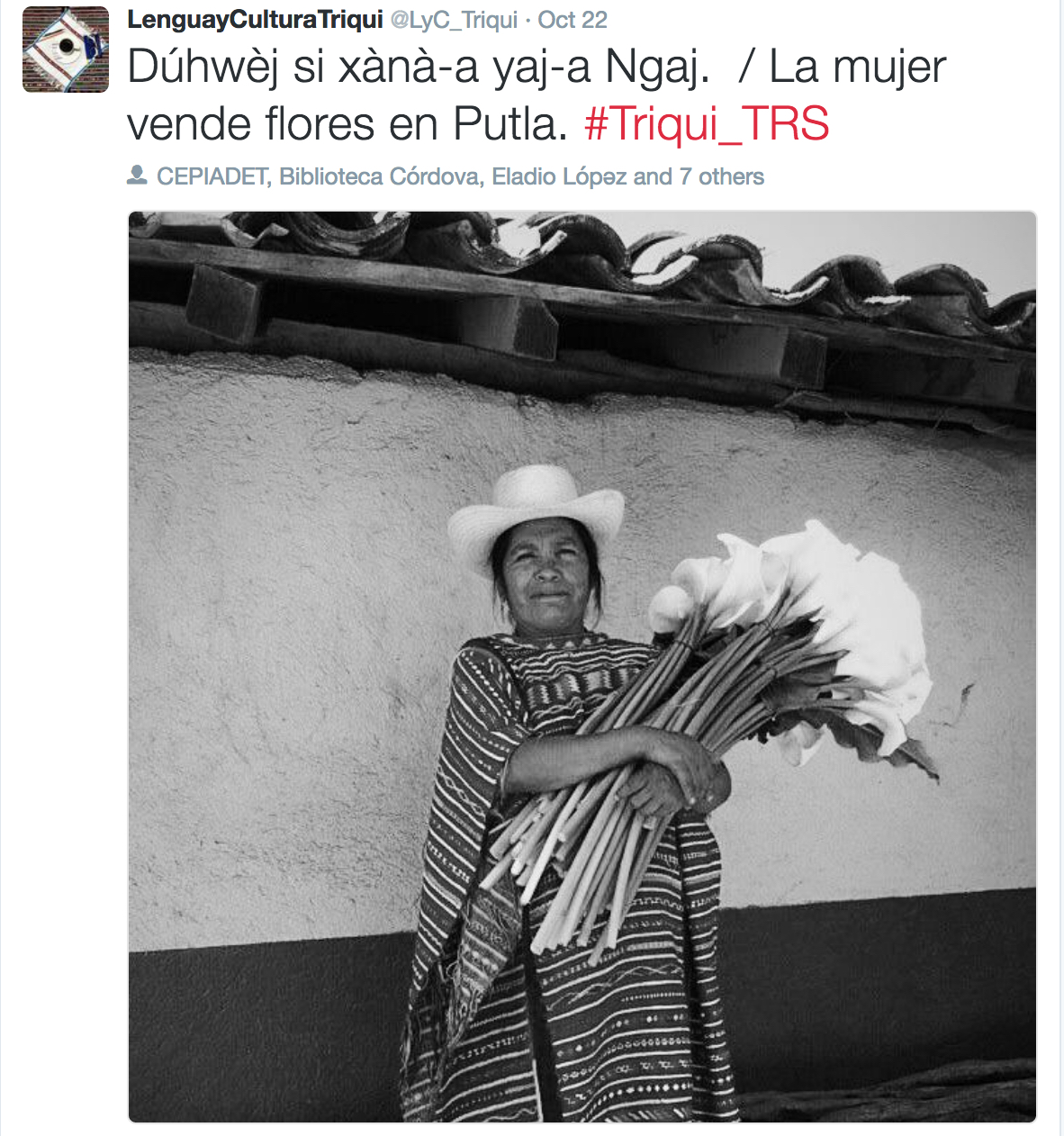Although TRS is not commonly written, the desire to write the language has increased considerably over the past decade and more people are writing the language by hand or in texts, either printed or online. Consequently, teachers, village leaders and community members are engaged in ongoing efforts to develop a writing system, however, not all native speakers of TRS are in agreement as to what these conventions should be. The TRS practical writing system generally changes depending upon the audience for whom it is intended. Linguists typically represent all tones in writing in addition to fortis-lenis sonorant consonant contrasts, word-final vowel length and multitone contours. Practical orthography is by and large simplified when it is written for native speakers of the language.
Probably the largest contemporary sample of written TRS is a translation of the New Testament by Felipe Santiago Rojas (2016), the consultant used in this research, which is available online (see http://triquidechicahuaxtla.org/es/page-2-0) . The spelling conventions in the online version of the New Testament translation are those that are discussed here and are used in the text below. Alternative spelling systems exist and are actively promoted by some teachers, village leaders and native language enthusiasts, both within the community, in schools and in online environments. In addition to the spelling conventions that are described here, alternate spelling practices will be highlighted where appropriate.
The diacritics used for indicating tone in the text included here are based on the five-tone system and were approved by committee in 2009 in San Andrés Chicahuaxtla and Santo Domingo del Estado. Tones in TRS are written using the following diacritics: ( ́ ) = 5; ( ̂ ) = 4; ( ) = 3; ( __ ) = 2 and ( ̀ ) = 1. Lexical items ending in one tone are written with one final vowel while those ending in two-tone sequences are usually (but not consistently) written by doubling the final vowel and marking the corresponding tones, for example ɡüiì [ɡwiː31] ‘people’ and gumàan [ɡumãː13] ‘rain’ in the text below. The orthographic system currently used does not account for words ending in three-tone sequences, such as húue [wːeː353] ‘straw mat’, mmii [mːiː323] ‘bridge’, or niì [niː313] ‘last night’. Alternate writing systems currently in use mark only three tones. High to extra high tones are indicated with an acute accent ( ́ ); mid tones are not marked, while low to extra low tones are marked with a grave accent ( ` ).
Triqui vowels are written as they are in Spanish (e.g., a, e, i, o, u) except for the close back unrounded vowel /ɯ/ that is written as ï and the mid central vowel /ə/ as ë, as in the TRS words kïj ï [kɯ3hɯ] ‘mountain’ and ë’ëj yiô’ [əʔəː32h ʒioʔ4] ‘hiccough’. There are some native speakers who write these sounds as barred or using strikethrough text, e.g., i and e. Native speakers of TRS who speak a dialect in which /ə/ and /ɯ/ have merged with /e/ and /i/ represent these sounds as e and i in writing.
TRS spelling conventions have changed over the past 65 years, therefore an explanation of some of the graphemes is warranted. For example, Longacre (1952, 1957, 1959), Good (1979), and Matsukawa (2009) represent voiceless velar stop /k/ as c before back vowels and qu before front vowels in accordance with Spanish spelling conventions. Today, however, there are many who write /k/ as k wherever it occurs.
Longacre (1952, 1957) and Good (1979) write voiceless and voiced bilabial-velar stops /kw/ and /ɡw/ as cu and gü before e and i in accordance with spelling conventions in Spanish, however, there are some native speakers who use the graphemes kw and gw to write these sounds. For example, based on spelling conventions used in the text presented here, the TRS words güendâ [ɡwen̪d̪aː4] ‘story’ and güiì [ɡwiː31] ‘people’ are sometimes written as gwendá and gwiì. Based on Spanish spelling, g is written as gu before e or i, however some native speakers write /ɡ/ as g wherever it occurs. Consequently the TRS word [ɡeː2] ‘surprise’ is written as gue as per the spelling conventions used in the text below but may be written as gè [ɡeː2] by some native speakers.
Voiceless and voiced postalveolar fricatives /ʃ/ and /ʒ/ are written as x and y respectively, for example: xi’ì [ʃiʔiː1] ‘sickness’, yuhue [ʒuweː3] ‘dog’ and yî’ [ʒi4ʔ] ‘elder’. In his dictionary, Good (1979) writes voiceless postalveolar fricative /ʃ/ as xx and voiced postalveolar fricative /ʒ/ as x, for example, xuhue [ʒuweː3] ‘dog’ (Good 1979:47); xutan [ʒut̪ãː3] ‘bee’ (Good, 1979:48) in comparison to guxxun’ [ɡuʃũ2ʔ] ‘we are going to take it away’ (Good 1979:95).
The saltillo < ‘ > is used to represent the glottal stop [ʔ] in accordance with spelling conventions used in the text below and reflects previous spelling conventions used by Longacre (1952, 1957), Good (1979), Mastukawa (2008, 2009), Elliott et al. (2012, 2016) and Santiago Rojas (2006, 2016). In TRC, the glottal stop is written using the saltillo < ‘ >, however, in TRQ it is represented by the grapheme h. Proponents of alternative writing systems of TRS have replaced the saltillo < ‘ > denoting a glottal stop [ʔ] with the grapheme h. Therefore, words such as ru’man [ruʔmãː3] ‘hole’, yî’ [ʒi4ʔ] ‘ancestors’ and ‘ue’e [ʔwe3ʔe] ‘ice’ are written by some as ruhman, yíh and hueh-e, respectively.
The use of grapheme h to represent the glottal stop [ʔ] in TRS is not uncommon and its popularity is growing. Figures 4 – 5 below show that many members and online contributors to LenguayCulturaTriqui Twitter site prefer using the grapheme h as opposed to the saltillo < ‘ > in words that have a glottal stop [ʔ]. According to the blog titled, “Pronunciación de la h” posted on the Lengua y Cultura Triqui WordPress™ website, “[h]ay autores que escriben este fonema con el apóstrofo ‘ en vez de h. Preferimos la h por cuestiones prácticas, pues es posible escribir dicha letra usando un teclado estándar de cualquier dispositivo electrónico, lo que facilitaría el envío de mensajes, correos electrónicos, publicaciones en redes sociales, etc.” For example, Figures 4 and 5 below are two recent posts from the website in which the glottal stop [ʔ] is represented as h. In Figure 4, sí gono’ò [siː53 ɡonoʔoː1] ‘doctor’ (literally, ‘medicine man’), is spelled sií gònòhò and dû’huej [du4ʔwe2h] ‘sell’ in Figure 5 is written as dúhwèj. As computers become more prevalent in San Andrés Chicahuaxtla and in the local school systems, extant keyboard symbols will undoubtedly influence the developing orthographic system of TRS. It would not be surprising that the grapheme h eventually replaces the saltillo < ‘ > for the glottal stop in the practical orthography of TRS.
 |
 |
FIGURES 4 and 5: Sample Twitter Posts from Lengua y Cultura Triqui
According to the spelling conventions used in the text below, grapheme h is mute and is used either: 1) at the beginning of a word that begins with two vowels, for example hio’óo [joʔoː53] ‘dirt’, or, 2) to indicate syllable divisions internally in words that consist of three or more contiguous vowels as in dahuee [d̪aweː23] ‘lake’ or ruhuâa [ruwaː43] ‘in’. Alternate spellings are yohóo, dawèe and ruwáa, respectively.
The voiceless glottal fricative /h/ is written as j in TRS, for example, asij [asi2h] ‘for’; kïj [kɯ3h] ‘mountain’ and sachij i [sa͡ʧi3hi] ‘elders, ancestors’. Words that contain /h/ and are followed by a vowel are now written by some teachers with a space or a hyphen between the laryngeal and the vowel, whereas at one time, they were written as one word (Longacre 1952, 1957; Good 1979). For example, sachij i [sa͡ʧi3hi] ‘elders, ancestors’ may be written as one word (as per Longacre 1952, 1957; Good 1979), or with a space or hyphenated in accordance with spelling conventions used today, thus resulting in the following three possibilities: sachiji, sachij i or sachij-i.
Grapheme n as the onset of a syllable is pronounced as a voiced alveolar nasal /n/, however when a vowel is followed by n, it signals nasalized pronunciation of the previous vowel, for example: nuguan’ [nuɣwã2ʔ] ‘word’; hian’anj an [j̃ãʔã2hã] ‘God’; or gumàan [ɡumãː13] ‘rain’. As indicated in § 2 above, some native speakers write [j̃] as ñ because they believe its pronunciation is similar to the voiced alveopalatal nasal /ɲ/ consonant in Spanish.
The representation of fortis-lenis sonorant consonant contrasts in practical orthography has been of considerable debate among the teachers, village leaders and community members. Orthographic systems used by Longacre (1952, 1957, 1959) and Good (1979) differentiated fortis from lenis sonorants by writing fortis consonants as geminates, for example: [mː nː lː jː] as mm, nn, ll, yy while fortis [wː] was represented in writing as <huu>. Alternate writing systems currently in use represent both fortis and lenis /w/ as w wherever it occurs. Therefore, words such as [d̪aweː2] ‘lake’ or [ruwaː43] ‘in’ are written dawè and ruwá rather than dahue or ruhuâa according to the spelling conventions used in the text. Santiago Rojas (2006) and Elliott et al. (2012, 2016) write fortis /jː/ as hii and lenis /j/ as hi.
Not all native speakers of TRS are in agreement whether or not fortis-lenis sonorant consonants should be represented in writing. Santiago Rojas reports (Elliott et al., 2012) that there are several teachers and school administrators in San Andrés Chicahuaxtla who reject the use of double consonants but that there are “still some people, although very few, who choose to write it the old way (i.e., using double consonants).” Consequently some native speakers of TRS are in favor of representing fortis-lenis sonorant consonant distinctions in writing while there are others who reject this. To date, no general consensus appears to have been reached.
Several of the graphemes currently used have not changed from earlier spelling conventions. For example, the voiceless denti-alveolar affricate /ts/ is represented as ts, the voiceless alveolar-palatal affricate /ʧ/ as ch, and the voiceless retroflex affricate /tʂ/ is written as chr. (For more information regarding spelling in TRS, see Elliott et al. 2012).
